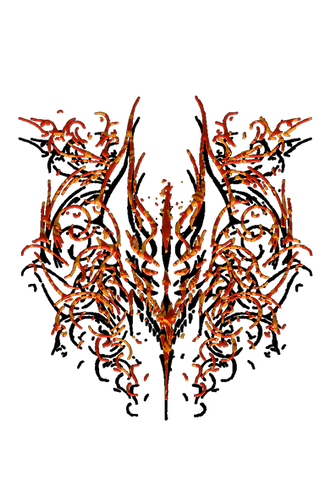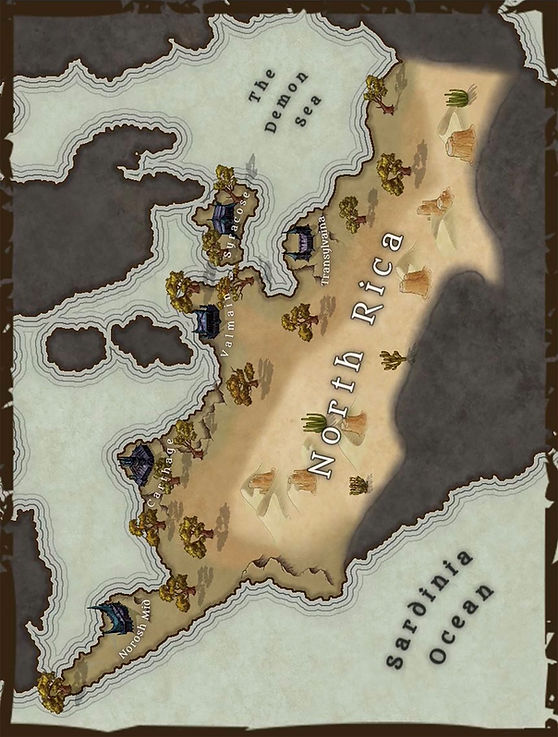

North Rica

Nestled in a realm of mystique and legend, North Rica's history unfurls like an ancient scroll, rich with tales of magic and valor. The land, originally known as Nitrell, invites us back to an era as far-reaching as 2031 BCD. Imagine a time where the air was thick with the scent of mystery, and the whispers of the past wove through the mountains and valleys.
During these early days, the Hell Rider Militia held sway, a secretive and formidable group whose very presence commanded awe and respect. Picture their silent, yet powerful, figures moving through the mist, cloaked in dark, flowing robes that seemed to shimmer with an otherworldly light. Their eyes, sharp and discerning, glowed with the knowledge of ancient spells and arcane secrets.
The Hell Riders were not just leaders; they were the living embodiment of magic and strength. Each member of this enigmatic militia possessed abilities that defied the laws of nature. They could summon storms with a gesture, heal wounds with a mere touch, and move with a speed and grace that seemed almost divine. Their magic was both a shield and a sword, a protective barrier against invaders and a weapon that ensured their dominance.
Under their rule, Nitrell flourished. The Hell Riders’ magic cultivated the land, turning barren fields into lush, fertile plains and dark forests into havens of prosperity. The towns and cities glistened with the glow of enchanted lights, and the people lived in an age of unprecedented peace and wealth. Trade routes thrived, fortified by the militia's might, and Nitrell became a beacon of strength and stability in a world often fraught with chaos.
Their governance was marked by strategic brilliance and a deep understanding of the arcane arts. The Hell Riders' ability to foresee and thwart threats before they could manifest kept the land secure and its people thriving. They trained relentlessly, perfecting their skills, and passing down their knowledge to ensure that Nitrell remained an impregnable fortress.
In this golden age, Nitrell was not just a kingdom but a sanctuary where magic and reality intertwined seamlessly. The Hell Riders’ influence permeated every aspect of life, from the towering citadels that dotted the landscape to the vibrant marketplaces where merchants traded exotic goods from far-flung lands. The very essence of their rule was etched into the stones and rivers, a testament to their unparalleled reign.
Thus, the history of North Rica, born from the ancient heart of Nitrell, is a tapestry woven with the threads of magic, strength, and enduring legacy. The era of the Hell Rider Militia stands as a beacon of what can be achieved when power is wielded with wisdom and the mysteries of the arcane are embraced to their fullest potential.
In 2031 BCD, the landscape of Nitrell transformed dramatically as the Hell Rider Militia swept in and seized control. This formidable faction didn’t just conquer the region; they etched a new era into the annals of history with their arrival. The Hell Riders were a force unlike any other, their presence immediately palpable and unmistakable. Cloaked in mystery and power, they commanded ancient arcane magic with an expertise that no one else could match.
As the Hell Riders took charge, their extraordinary magical abilities became the stuff of legend. Whispers of their power spread like wildfire, tales of spells that could turn the tide of battle in an instant and incantations that could summon forces beyond comprehension. Their very presence seemed to bend reality, creating a palpable aura of fear and awe among both allies and enemies.
The Hell Riders didn't merely secure Nitrell’s borders; they fortified them with an impenetrable shield of strategy and strength. Their tactical acumen was unparalleled, orchestrating maneuvers that left their foes bewildered and defeated. Under their dominion, Nitrell’s influence didn't just remain steady—it surged forward, extending its reach far beyond its previous limits.
Villages and cities that once lay beyond Nitrell’s control now found themselves under its expansive shadow, integrated into a growing empire guided by the Hell Riders' iron will. The streets buzzed with new energy, a mixture of apprehension and admiration, as people adapted to the changes brought by their new rulers. Every corner of Nitrell bore the mark of their dominion, a testament to their unmatched power and indomitable spirit. Thus, the Hell Rider Militia didn't just mark a significant chapter in Nitrell's history—they rewrote the entire narrative, forever changing the region's destiny with their extraordinary magical prowess and strategic genius.
The Hell Riders’ rule was characterized by a combination of strict governance and cultural flourishing. They implemented a rigid code of honor, discipline, and loyalty, which became the backbone of Nitrell’s society. Under their guidance, the economy thrived due to prosperous trade with neighboring lands and distant civilizations. Cultural exchanges brought a wealth of knowledge, art, and technology, enriching the lives of Nitrell's citizens.
The Hell Riders' military dominance was unparalleled. Their strategic use of magic in warfare not only protected Nitrell from invasions but also allowed them to conquer and assimilate surrounding territories. This era was marked by significant economic growth, with resources from conquered lands fueling Nitrell’s advancement. The society’s structure was meticulously organized, ensuring stability and prosperity.
The legacy of the Hell Rider Militia endured long after their rule, deeply influencing North Rica's traditions, beliefs, and governance structures. Their era came to a close as internal strife and external pressures mounted, leading to their eventual decline. However, the principles they established remained integral to the region's identity.
In 50 PC, a transformative event occurred: the Free Militia of Vampires claimed ownership of the territory, establishing North Rica as an independent nation. This new ruling entity adopted the identity of the Matanzas Federation. The transition marked a significant shift in governance and societal norms, as the Vampires brought with them a new political and military ideology.
The Matanzas Federation transformed North Rica into a military dictatorship. The federation’s rule was characterized by absolute power, with personal freedoms and individual rights heavily suppressed to maintain order and control. Dissent and opposition were not tolerated, and those who opposed the regime were swiftly dealt with.
The hierarchical command system established by the Matanzas Federation was strict and unyielding. At the top was the general, a position of great honor and responsibility. The general embodied the nation’s values and aspirations, and the selection process was rigorous. A general could either be chosen by the incumbent based on merit and loyalty or prove their worthiness through battle.
Beneath the general were five commanders, each governing a specific city. This structure allowed for efficient coordination, rapid response to threats, and effective resource management. The unity between the general and the commanders formed the backbone of the country's governance, ensuring stability and order.
Under the Matanzas Federation, North Rica experienced significant societal changes. The federation’s strict control mechanisms suppressed cultural and intellectual freedoms, leading to a society where conformity was mandatory, and individuality was stifled. Despite this, the period was marked by relative stability and order.
The Matanzas Federation prioritized military strength and economic control. Resources were allocated to maintain a formidable army, and economic policies were designed to ensure the regime’s longevity. This focus on military and economic power allowed North Rica to remain a significant force in the region.
Despite the oppressive nature of the Matanzas Federation, some aspects of cultural heritage from the Hell Rider Militia era persisted. Traditions, beliefs, and practices from that golden age were subtly maintained and adapted to fit the new societal norms imposed by the federation.
As the world evolved, so did North Rica. The rigid structures of the Matanzas Federation eventually gave way to more modern forms of governance. The transition was gradual, marked by internal reforms and external influences. This period saw the re-emergence of individual freedoms and the development of a more inclusive society.
Modern North Rica focused on economic development, leveraging its historical strengths in trade and resource management. The government implemented policies to encourage innovation, attract foreign investment, and improve the standard of living for its citizens. This period of economic renaissance brought about significant improvements in infrastructure, education, and healthcare.
The modern era also witnessed a cultural renaissance. Freed from the oppressive controls of the past, North Rica’s citizens began to explore and celebrate their rich cultural heritage. Arts, literature, and music flourished, reflecting a renewed sense of identity and pride in their historical legacy.
The history of North Rica is a testament to the resilience and adaptability of its people. From the mystical rule of the Hell Rider Militia to the oppressive regime of the Matanzas Federation, and finally to a modern, thriving society, North Rica's journey is marked by transformation and continuity. The legacies of its past rulers continue to influence its present and future, shaping a nation that honors its history while embracing progress and innovation.





